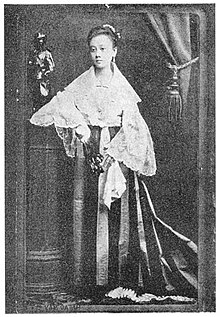Women in the Philippines
 |
|
| Gender Inequality Index | |
|---|---|
| Value | 0.418 (2012) |
| Rank | 77th |
| Maternal mortality (per 100,000) | 99 (2010) |
| Women in parliament | 22.1% (2012) |
| Females over 25 with secondary education | 65.9% (2010) |
| Women in labour force | 49.7% (2011) |
| Global Gender Gap Index | |
| Value | 0.7832 (2013) |
| Rank | 5th out of 144 |
The role of women in the Philippines is explained based on the context of Filipino culture, standards, and mindsets. The Philippines is described to be a nation of strong women, who directly and indirectly run the family unit, businesses, government agencies and haciendas.
Although they generally define themselves in the milieu of a male-dominated post-colonial society, Filipino women live in a culture that is focused on the community, with the family as the main unit of society, but not always as this is a stereotype. It is in this framework of Philippine hierarchical structure, class differences, religious justifications, and living in a globally developing nation wherein Filipino women are respected well by men. Compared to other parts of Southeast Asia, women in Philippine society have always enjoyed a greater share of equality.
Some pre-colonial social structures of the Philippines gave equal importance to maternal and paternal lineage. This bilateral kinship system accorded Philippine women enormous power within a clan. They were entitled to property, engage in a trade and could exercise their right to divorce her husband. They could also become village chiefs in the absence of a male heir. Before the arrival of the Spaniards, Filipino women could also achieve status as medicine women or high-priestesses and astrologers.
In the precolonial era of the Phlippines there are numerous women are entitled as a Hara and Dayang , the female presence in the Noble caste are prominent in the kinship system in the Philippine societies, here are the examples of notable Queens in the Philippine history:
Although Christian values were supposed to be spread through the population, missionaries and priests soon realized that they'd be better off adapting their doctrine as much as possible to the local customs, rather than trying to impose it. As it happened all over Asia, women in the Philippines were expected to become caring and nurturing mothers for their own children and take care of most household chores. Also a trait found all over Asia was the preference of most families to have male children instead of females.
...
Wikipedia
